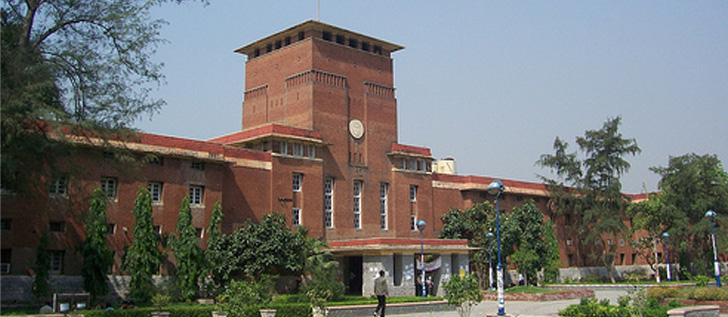Education in India
Education in India is matter of prime concern for the government of India. The University Grants Commission (UGC) coordinates, determines and maintains the standards of education at various levels. There are many professional bodies, which are responsible for accreditations of the courses, as well as providing grants to the different undergraduate courses.
India, with its diversity fascinates one and all. Indian Education has recently gained world recognition. Many students from foreign countries are eyeing the country for gaining higher qualifications. Though, illiteracy is a problem in India, the country amazes outsiders with its vast pool of talent.
The Indian economy has grown in leaps and bounds in the recent years and hence there is a necessity to educate the masses to accelerate the growth process. It is interesting to note how the Indian education machinery works.
Title Professional Councils in India are:
- All India Council for Technical Education (AICTE)
- Indian Council for Agriculture Research (ICAR)
- Distance Education Council (DEC)
- National Council for Teacher Education (NCTE)
- Bar Council of India (BCI)
- Medical Council of India (MCI)
- Rehabilitation Council of India (RCI)
- Indian Nursing Council (INC)
- Central Council of Homeopathy (CCH)
- Pharmacy Council of India (PCI)
- Central Council of Indian Medicine (CCIM)
- Dentist Council of India (DCI)
Education System of India
Till the recent past it was believed that premier education is not available in India, but the current development in the educational sector has led to the belief that quality education is indeed available in India. Research done in the past has highlighted loopholes in the curriculum and methodologies but these criticisms had acted upon and amendments were made. These included changes in the syllabus, introduction of new courses and dynamic methodologies. Modern infrastructures and teachers with adequate training are facilitating cutting-edge delivery of content; connected E-learning (called C- learning) is in vogue and today, India is attracting students from South Africa, China, Canada, France, Germany, Canada, Australia, UK and USA.
This unbelievable progress in the educational scenario also includes low costs of tuitions as compared to the western countries. The basic divisions in the academics include primary, secondary, senior secondary and higher education. Elementary education is till standard 8 while secondary and higher secondary education consists two years each. Graduation is between three to five years depending on the course after which there is an option for post-graduation (a two-year course) and research.
Today education system in India can be divided into many stages.
- Pre- Primary - It consists of children of 3-5 years of age studying in nursery, lower kindergarten and upper kindergarten. At this stage student is given knowledge about school life and is taught to read and write some basic words.
- Primary - It includes the age group of children of 6-11 years studying in classes from first to fifth.
- Middle - It consists of children studying in classes from sixth to eighth.
- Secondary - it includes students studying in classes ninth and tenth.
- Higher Secondary - Includes students studying in eleventh and twelfth classes.
- Undergraduate - Here, a student goes through higher education, which is completed in college. This course may vary according to the subject pursued by the student. For medical student this stage is of four and a half years plus one year of compulsory internship, while a simple graduate degree can be attained in three years.
- Postgraduate - After completing graduation a student may opt for post graduation to further add to his qualifications.
Education Governing Bodies
- The Central Board of Secondary Education (CBSE): This is the main governing body of education system in India. It has control over the central education system. It conducts exam and looks after the functioning of schools accredited to central education system.
- The Council of Indian School Certificate Examination (CISCE): It is a board for Anglo Indian Studies in India. It conducts two examinations 'Indian Certificate of Secondary Education' and 'Indian School Certificate'. Indian Certificate of secondary education is a k-10 examination for those Indian students who have just completed class 10th and Indian school certificate is a k-12 public examination conducted for those studying in class 12th.
- The State Government Boards: Apart from CBSE and CISCE each state in India has its own State Board of education, which looks after the educational issues.
- The National Open School: It is also known as National Institute of Open Schooling. It was established by the Government Of India in 1989. It is a ray of hope for those students who cannot attend formal schools.
- The International School: It controls the schools, which are accredited to curriculum of international standard.
Elementary Education
According to the Constitution of India, elementary education is a fundamental right of children in the age group of 6-14 years. India has about 688,000 primary schools and 110,000 secondary schools. According to statistics two third of school going age children of India are enrolled in schools but the figures are deceptive as many don't attend schools regularly. At least half of all students from rural area drop out before completing school. The government has rolled out many plans to increase the percentage of elementary education. The plans such as 'Sarva Siksha Abhiyan (SSA), District Primary Education Program (DPEP), Operation Blackboard, Mid Day Meal have been successful to great extent.
Sarva Siksha Abhiyan (SSA)
The main goal of this program is that all children of 6-11 years of age should complete primary education by the year 2007 and all children of 6-14 years of age should complete eight years of schooling by 2010. This plan covers the whole country with special emphasis on girl education and education of Schedule Caste (SC) and Schedule Tribe (ST) children and children with special needs. The SSA centers are mainly opened in those areas, which do not have any school or where schools are very far off. Special girl oriented programs include:
- Girl education at elementary level.
- National Program for Education of Girls at Elementary Level (NPEGEL)
- Kasturba Gandhi Balika Vidyalaya (KGBV)
- Mahila Samakhya Scheme
District Primary Education Program
This program was launched in 1994 with the objective of universalization of primary education. Its main features are Universal Access, Universal Retention and Universal Achievement. It aims that the primary education should be accessible to each and every child of school going age, once a child is enrolled in school he/ she should be retained there. The final step is achievement of the goal of education. The main components of this program are:
- Construction of classrooms and new schools
- Opening of non-formal schooling centers
- Setting up early childhood education centers.
- Appointment of teachers.
- Providing education to disabled children.
Operation Blackboard
It was started in 1987-88. The aim of this program is to improve human and physical resource availability in primary schools of India. According to this program every primary school should have at least two rooms, two teachers and essential teaching aids like blackboard, chalk, duster etc.
National Bal Bhavan
The National Bal Bhavan was opened with the aim of developing overall personalities of children of all strata of society irrespective of their caste, creed, religion and gender. It supplements school education by helping children to learn in play way and natural environment.
Other important endeavors taken up by Indian government for the development of education in India includes:
- Navodaya Vidyalaya Samiti
- Kendriya Vidyalaya Sangathan
- Integrated Education for disabled children
- National Council of Educational Research and Training
Present Scenario of Education System
The present educational system of India is an implantation of British rulers. Wood's Dispatch of 1854 laid the foundation of present system of education in India. Before the advent of British in India, education system was private one. With the introduction of Wood's Dispatch known as Magna Carta of Indian education, the whole scenario changed. The main purpose of it was to prepare Indian Clerks for running local administration. Under it the means of school educations were the vernacular languages while the higher education was granted in English only. British government started giving funds to indigenous schools in need of help and thus slowly some of the schools became government-aided.
Contemplating on the new system which was introduced Mahatma Gandhi expressed his anguish in following words, "I say without fear of my figures being challenged successfully, that today India is more illiterate than it was fifty or a hundred years ago, and so is Burma, because the British administrators, when they came to India, instead of taking hold of things as they were, began to root them out. They scratched the soil and began to look at the root, and left the root like that, and the beautiful tree perished. The village schools were not good enough for the British administrator, so he came out with his program. Every school must have so much paraphernalia, building, and so forth. Well, there were no such schools at all. There are statistics left by a British administrator which show that, in places where they have carried out a survey, ancient schools have gone by the board, because there was no recognition for these schools, and the schools established after the European pattern were too expensive for the people, and therefore they could not possibly overtake the thing. I defy anybody to fulfill a program of compulsory primary education of these masses inside of a century. This very poor country of mine is ill able to sustain such an expensive method of education. Our state would revive the old village schoolmaster and dot every village with a school both for boys and girls. "
The recent initiatives of the government include the following
- An Information Technology teacher should be appointed in every school.
- The ICSE and CBSE curriculums have gained eminence.
- Unit tests from Class 1 till Class 8 has been done away with in Maharashtra.
- Foreign universities are being given green signals to open campus in India. These universities are also collaborating with Indian institutions to disperse combines curriculums.
Historical Background of Indian Education
Traditional Indian education boasts of the Vedas, the Puranas, the Ayurveda, the Arthasashtra, and many more and is a marvel of the Indian intellect. In the system of Gurukula (ancient Indian system of dispersing knowledge) the adolescent boys stayed in the house of the teacher (guru) to gain knowledge over a stipulated time-period. The Brahmacharya (celibacy) state was observed till a certain age while women and lower caste people had no access to education in the Middle Ages. The reform movement spread by the Sufi, Bhakti, Jain and Buddhist religions reduced the pain of the oppressed segments of the society and educational reforms gained eminence in the nineteenth century.
After independence, education for all was the mission of the government. The unhealthy practice of discriminations was removed by the 86th Constitutional Amendments and education has been made compulsory for the age group 6 to 14. The significant gap between the rate of urban and rural literacy is being bridged and the UGC was set up in the year 1953 to regulate the processes of educational development in the country.
Currently, there are 17000 plus colleges, around 20 universities (central), 217 universities (state), and many deemed universities as well as national institutions. The national institutions of international fame are the IIT's and the IIM's. The Indian School of Business (ISB) in Hyderabad holds a global rank of 15 in the field of management education.
However, the efforts of upgrading the standards of Indian Education are not meeting with success, due to hurdles in accessibility, poverty and other factors. Due to widespread poverty the government of India is not able to achieve higher success in the implemented projects. The 11th 5- year plan alleviates the importance of development in the education sector and primary education as well as higher education is given equal importance in this plan.
Professional Colleges in India
Engineering Colleges in India
- IIT Delhi
- IIT Guwahati
- IIT Hyderabad
- IIT Kanpur
- IIT Kharagpur
- IIT Madras
- IIT Mumbai
- IIT Jodhpur
- IIT Roorkee
- IIT Ropar
MBA Colleges in India
In India education in management is one of the most sort out courses. The institutes, which impart education in management, are known as "Business Schools". In India management education is given at two levels, undergraduate and post-graduate. Undergraduate degree courses include BBA, BBS, BBM. Postgraduate degree course is known as MBA (Masters of Business Administration). Some of the important Business schools of India are:
- Indian Institute of Management, Ahmedabad
- Indian Institute of Management, Bangalore
- Indian Institute of Management, Kolkata
- Indian Institute of Management, Lucknow
- Indian Institute of Management, Indore
- Faculty of Management Studies, Delhi
- Indian Institute of Foreign Trade, Delhi
- Symbiosis, Pune
- JBIMS, Mumbai
- XLRI, Jamshedpur
Distance Education in India
Indian Education system offers distance education to those who cannot join regular schools or colleges. National Institute of Open Schooling offers school education through distance learning.
University Education is also offered thorough distance learning. Many college courses like in arts (history, economics, literature, Islamic studies), commerce (finance, banking, accounting) are offered by Indian universities. Apart from these, professional courses in management, mass media, para medical, engineering, law, travel and tourism are also part of distance education in India.
Some important facts about Education in India
- Ayurveda is the earliest school of medicine known to the world and 'charaka' is known as the father of Ayurveda. He developed this system some 2500 years back.
- Takshila was the first university of world established in 700 B.C.
- Nalanda University, built in 4 AD, was considered to be the honor of ancient Indian system of education as it was one of the best Universities of its time in the subcontinent.
- Indian language Sanskrit is considered to be the mother of many modern languages of world.
- Place value system was developed in India in 100 B.C.
- India was the country, which invented number system.
- Aryabhatta, the Indian scientist, invented digit zero.
- Trigonometry, algebra and calculus studies were originated in India.
Last Updated on : March 21, 2025



























